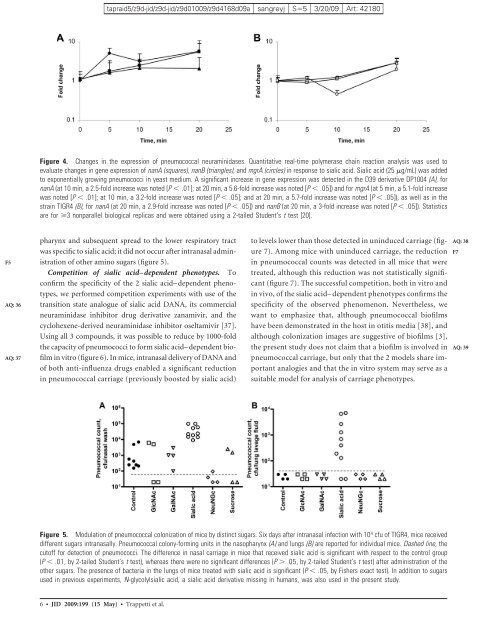5 The role of quorum-sensing in the virulence of Pseudomonas ...
5 The role of quorum-sensing in the virulence of Pseudomonas ...
5 The role of quorum-sensing in the virulence of Pseudomonas ...
You also want an ePaper? Increase the reach of your titles
YUMPU automatically turns print PDFs into web optimized ePapers that Google loves.
F5<br />
AQ: 36<br />
AQ: 37<br />
Figure 4. Changes <strong>in</strong> <strong>the</strong> expression <strong>of</strong> pneumococcal neuram<strong>in</strong>idases. Quantitative real-time polymerase cha<strong>in</strong> reaction analysis was used to<br />
evaluate changes <strong>in</strong> gene expression <strong>of</strong> nanA (squares), nanB (triangles), and mgrA (circles) <strong>in</strong> response to sialic acid. Sialic acid (25 �g/mL) was added<br />
to exponentially grow<strong>in</strong>g pneumococci <strong>in</strong> yeast medium. A significant <strong>in</strong>crease <strong>in</strong> gene expression was detected <strong>in</strong> <strong>the</strong> D39 derivative DP1004 (A), for<br />
nanA (at 10 m<strong>in</strong>, a 2.5-fold <strong>in</strong>crease was noted [P � .01]; at 20 m<strong>in</strong>, a 5.6-fold <strong>in</strong>crease was noted [P � .05]) and for mgrA (at 5 m<strong>in</strong>, a 5.1-fold <strong>in</strong>crease<br />
was noted [P � .01]; at 10 m<strong>in</strong>, a 3.2-fold <strong>in</strong>crease was noted [P � .05]; and at 20 m<strong>in</strong>, a 5.7-fold <strong>in</strong>crease was noted [P � .05]), as well as <strong>in</strong> <strong>the</strong><br />
stra<strong>in</strong> TIGR4 (B), for nanA (at 20 m<strong>in</strong>, a 2.9-fold <strong>in</strong>crease was noted [P � .05]) and nanB (at 20 m<strong>in</strong>, a 3-fold <strong>in</strong>crease was noted [P � .05]). Statistics<br />
are for �3 nonparallel biological replicas and were obta<strong>in</strong>ed us<strong>in</strong>g a 2-tailed Student’s t test [20].<br />
pharynx and subsequent spread to <strong>the</strong> lower respiratory tract<br />
was specific to sialic acid; it did not occur after <strong>in</strong>tranasal adm<strong>in</strong>istration<br />
<strong>of</strong> o<strong>the</strong>r am<strong>in</strong>o sugars (figure 5).<br />
Competition <strong>of</strong> sialic acid–dependent phenotypes. To<br />
confirm <strong>the</strong> specificity <strong>of</strong> <strong>the</strong> 2 sialic acid–dependent phenotypes,<br />
we performed competition experiments with use <strong>of</strong> <strong>the</strong><br />
transition state analogue <strong>of</strong> sialic acid DANA, its commercial<br />
neuram<strong>in</strong>idase <strong>in</strong>hibitor drug derivative zanamivir, and <strong>the</strong><br />
cyclohexene-derived neuram<strong>in</strong>idase <strong>in</strong>hibitor oseltamivir [37].<br />
Us<strong>in</strong>g all 3 compounds, it was possible to reduce by 1000-fold<br />
<strong>the</strong> capacity <strong>of</strong> pneumococci to form sialic acid–dependent bi<strong>of</strong>ilm<br />
<strong>in</strong> vitro (figure 6). In mice, <strong>in</strong>tranasal delivery <strong>of</strong> DANA and<br />
<strong>of</strong> both anti-<strong>in</strong>fluenza drugs enabled a significant reduction<br />
<strong>in</strong> pneumococcal carriage (previously boosted by sialic acid)<br />
to levels lower than those detected <strong>in</strong> un<strong>in</strong>duced carriage (figure<br />
7). Among mice with un<strong>in</strong>duced carriage, <strong>the</strong> reduction<br />
<strong>in</strong> pneumococcal counts was detected <strong>in</strong> all mice that were<br />
treated, although this reduction was not statistically significant<br />
(figure 7). <strong>The</strong> successful competition, both <strong>in</strong> vitro and<br />
<strong>in</strong> vivo, <strong>of</strong> <strong>the</strong> sialic acid–dependent phenotypes confirms <strong>the</strong><br />
specificity <strong>of</strong> <strong>the</strong> observed phenomenon. Never<strong>the</strong>less, we<br />
want to emphasize that, although pneumococcal bi<strong>of</strong>ilms<br />
have been demonstrated <strong>in</strong> <strong>the</strong> host <strong>in</strong> otitis media [38], and<br />
although colonization images are suggestive <strong>of</strong> bi<strong>of</strong>ilms [3],<br />
<strong>the</strong> present study does not claim that a bi<strong>of</strong>ilm is <strong>in</strong>volved <strong>in</strong><br />
pneumococcal carriage, but only that <strong>the</strong> 2 models share important<br />
analogies and that <strong>the</strong> <strong>in</strong> vitro system may serve as a<br />
suitable model for analysis <strong>of</strong> carriage phenotypes.<br />
Figure 5. Modulation <strong>of</strong> pneumococcal colonization <strong>of</strong> mice by dist<strong>in</strong>ct sugars. Six days after <strong>in</strong>tranasal <strong>in</strong>fection with 10 4 cfu <strong>of</strong> TIGR4, mice received<br />
different sugars <strong>in</strong>tranasally. Pneumococcal colony-form<strong>in</strong>g units <strong>in</strong> <strong>the</strong> nasopharynx (A) and lungs (B) are reported for <strong>in</strong>dividual mice. Dashed l<strong>in</strong>e, <strong>the</strong><br />
cut<strong>of</strong>f for detection <strong>of</strong> pneumococci. <strong>The</strong> difference <strong>in</strong> nasal carriage <strong>in</strong> mice that received sialic acid is significant with respect to <strong>the</strong> control group<br />
(P � .01, by 2-tailed Student’s t test), whereas <strong>the</strong>re were no significant differences (P � .05, by 2-tailed Student’s t test) after adm<strong>in</strong>istration <strong>of</strong> <strong>the</strong><br />
o<strong>the</strong>r sugars. <strong>The</strong> presence <strong>of</strong> bacteria <strong>in</strong> <strong>the</strong> lungs <strong>of</strong> mice treated with sialic acid is significant (P � .05, by Fishers exact test). In addition to sugars<br />
used <strong>in</strong> previous experiments, N-glycolylsialic acid, a sialic acid derivative miss<strong>in</strong>g <strong>in</strong> humans, was also used <strong>in</strong> <strong>the</strong> present study.<br />
6 ● JID 2009:199 (15 May) ● Trappetti et al.<br />
tapraid5/z9d-jid/z9d-jid/z9d01009/z9d4168d09a sangreyj S�5 3/20/09 Art: 42180<br />
AQ: 38<br />
F7<br />
AQ: 39














